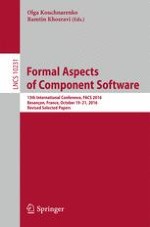This book constitutes the thoroughly revised selected papers from the 13th International Conference on Formal Aspects of Component Software, FACS 2016, held in Besançon, France, in October 2016.
The 11 full papers presented together with one tool paper and 3 invited papers were carefully reviewed and selected from 27 submissions. FACS 2016 is concerned with how formal methods can be used to make component-based and service-oriented software development succeed. Formal methods have provided a foundation for component-based software by successfully addressing challenging issues such as mathematical models for components, composition and adaptation, or rigorous approaches to verification, deployment, testing, and certification.

